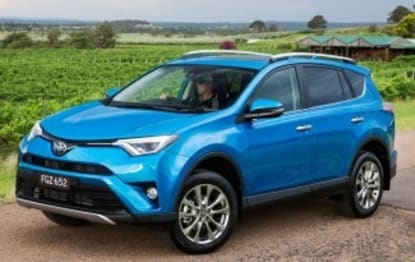The original compact SUV has bulked up considerably, morphing into a sturdy, smooth and safe family wagon.
You're looking at the best selling SUV in Australia — according to Toyota's press blurb, that is.
Well, sorta kinda maybe. It's true the RAV4 has just become the first SUV in Australia to hit 250,000 sales, though it hasn't claimed top spot in the compact SUV sector since 2007.
Mazda's CX-5 has smoked the class since 2012 and the Toyota has lost out to Subaru's Forester and the Nissan X-Trail in some years as well. But hey, this is the car business, so let's not quibble with facts. The original RAV4, launched in 1994 as a funky little funmobile for 20-somethings, can rightly claim to be the original compact SUV.
It's since gone through four generations and morphed into a family-sized freighter — you could almost call it a Camry wagon — ideally suited to 30-somethings with a couple of young kids.
This model, introduced in 2013, gets sharper sheet metal for 2016, plus new cabin decor, updated multimedia and worthwhile safety improvements. So how does Australia's top-selling (cough) SUV rate in 2016?
Design
RAV's new suit includes a front end on steroids, LED lights all around, tauter profile and new wheels — the mid-spec GXL gains classy black 18-inch wheels with machined spokes.
The RAV is hardly a sporty looking (or driving) device but 18-inch wheels (also standard on the top-spec Cruiser, tested here) give it a pleasingly proportioned stance. The GX poverty pack still wears 17-inch steel wheels and looks all the more dumpy for it. Inside, the ugly, messy dash introduced in 2013 remains, still with a weirdly protruding leading edge that creates a cavernous black void beneath, too many buttons and switches placed with little thought as to their ease of use and, for some bizarre reason, three styles of air vents.
You get a flat 1.8m-long floor, so you can almost move house with the RAV
It looks like the product of an unresolved argument among several designers. Or just laziness.
The GXL and Cruiser gain a bright, informative instrument panel, with a 4.2-inch TFT display in the centre. RAV's 6.1-inch multimedia touchscreen is simple enough to operate, it's also easy to pair your phone and the voice control speaks your language most of the time. That said, the seven-inch tablet-style screen introduced on new HiLux and Fortuner would have been a useful upgrade here, too.
Cruiser's power-adjustable driver's seat gives excellent support, though some will find the firm cushion bolsters a tad squeezy on the thighs. Rear legroom is best in class and the long, firm bench, with an adjustable backrest, is well suited to child restraints.
Cruiser's power-operated tailgate gives access a low, easy-to-load floor with a space-saver underneath. You get 577L of cargo volume with all seats occupied, which is at the more capacious end of the class.
Drop either side of the 60-40 split-fold rear seat forward and you get a flat 1.8m-long floor, so you can almost move house with the RAV.
About town
Toyota has dialled a snappy launch feel into the ECU, so the RAV4 jumps away smartly at the lights and its drivetrain of 2.5-litre four-cyinder and six-speed automatic is refined and responsive around town.
It's also frugal. We recorded 9.0-10.0L/100km — not bad for a 1600kg AWD petrol wagon in Sydney traffic. Regular unleaded is recommended.
Toyota's 2016 safety upgrade, standard on the Cruiser and a $2500 option on the GXL automatic, is tailor-made for city driving. It includes front parking sensors, forward collision warning with automatic emergency braking, blind spot monitoring and rear cross traffic alert, which warns you of potential hazards when reversing out of a parking spot.
You get a smooth, controlled, quiet ride and secure roadholding
The only notable issue around town is fairly heavy electric steering at shopping centre carpark speeds.
On the road
The RAV4 has no bad highway habits but you can buy a lot more performance for less elsewhere and it's also a long way from the best in class drive. That would involve a stoush with Subaru's Forester, Mazda's CX-5 and the Ford Kuga.
Toyota sets its SUVs up for comfort rather than speed, so you get a smooth, controlled, quiet ride and secure roadholding. Engine, wind and road noise are low. Expect about 7.0L/100km on the highway.
The Cruiser's all-wheel drive pays dividends in the wet and on dirt, where a lockable centre differential and hill descent control are also useful.
This year's safety update includes several hi-tech highway helpers, including trailer sway control, radar cruise control, automatic high-beam switching and lane departure warning. The latter also has a self-steering function, which can gently nudge you back into your lane if your wheels touch the white lines.













